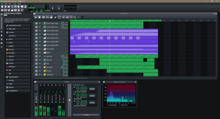LMMS
 | |
 Screenshot of a project in LMMS 1.2.1 | |
| Original author(s) | Paul Giblock Tobias Junghans[1] |
|---|---|
| Developer(s) | LMMS developers |
| Initial release | 2004; as Linux MultiMedia Studio |
| Stable release | 1.2.2[2]
/ 4 July 2020; 9 November 2020 |
| Repository | |
| Written in | C++ with Qt[3] |
| Operating system | Cross-platform: Windows, macOS, Linux, Haiku |
| Platform | x86 and x86-64 (Linux, macOS, Windows), only Linux: arm64, armel, armhf, mips, mips64el, mipsel, ppc64el, s390x[3] |
| Available in | 20 languages[4] |
| Type | Digital audio workstation |
| License | GPL-2.0-or-later[5] |
| Website | lmms |
LMMS (formerly Linux MultiMedia Studio[6]) is a digital audio workstation application program. It allows music to be produced by arranging samples, synthesizing sounds, entering notes via computer keyboard or mouse (or other pointing device) or by playing on a MIDI keyboard, and combining the features of trackers and sequencers. It is free and open source software, written in Qt and released under GPL-2.0-or-later.
System requirements[edit]
LMMS is available for multiple operating systems, including Linux, OpenBSD, macOS, and Windows. It requires a 1 GHz CPU, 512 MB of RAM and a two-channel sound card.[7]
Program features[edit]
LMMS accepts soundfonts and GUS patches, and it supports the Linux Audio Developer's Simple Plugin API (LADSPA) and LV2 (only master branch, since 24.05.2020). It can use VST plug-ins on Win32, Win64, or Wine32. The nightly versions support LinuxVST. Currently the macOS port doesn't support them.[8][9]
It can import Musical Instrument Digital Interface (MIDI) and Hydrogen files and can read and write customized presets and themes.[10]
Audio can be exported in the Ogg, FLAC, MP3, and WAV file formats.[11]
Projects can be saved in the compressed MMPZ file format or the uncompressed MMP file format.[12]
Editors[edit]
- Song Editor – for arranging instruments, samples, groups of notes, automation, and more
- Beat+Bassline Editor – for quickly sequencing rhythms
- FX Mixer – for sending multiple audio inputs through groups of effects and sending them to other mixer channels, infinite channels are supported
- Piano Roll – edit patterns and melodies
- Automation Editor – move almost any knob or widget over the course of the song
-
Song Editor
-
Beat+Bassline Editor
-
FX mixer
-
Piano Roll
-
Automation Editor
Audio plug-ins[edit]
LMMS includes a variety of audio plug-ins that can be drag-and-dropped onto instrument tracks in the Song Editor and Beat+Bassline Editor.
Synthesizer plugins:
- BitInvader – wavetable-lookup synthesis
- FreeBoy – emulator of Game Boy audio processing unit (APU)
- Kicker – bass drum synthesizer
- LB302 – imitation of the Roland TB-303
- Mallets – tuneful percussion synthesizer
- Monstro – 3-oscillator synthesizer with modulation matrix
- Nescaline – NES-like synthesizer
- OpulenZ – 2-operator FM synthesizer
- Organic – organ-like synthesizer
- Sf2 Player – a Fluidsynth-based Soundfont player
- SID – emulator of the Commodore 64 chips
- TripleOscillator - 3-oscillator synthesizer with 5 modulation modes: MIX, SYNC, PM, FM, and AM
- Vibed – vibrating string modeler
- Watsyn – 4-oscillator wavetable synthesizer
- Xpressive - mathematical expression parser synthesizer (only in alpha)
- ZynAddSubFX
Other plugins
- AudioFileProcessor (AFP) – basic sampler with trimming and looping capabilities
- SlicerT – slicer with tempo detection (only in nightly)
- VeSTige - interface for VST plugins
Standards[edit]
- Musical Instrument Digital Interface (MIDI)
- SoundFont (SF2)
- Virtual Studio Technology (VST)
- Linux Audio Developer's Simple Plugin API (LADSPA)
- LV2 (only master branch, since 24.05.2020)
- Gravis Ultrasound (GUS) patches (PatMan)
- JACK Audio Connection Kit (JACK)
- ZynAddSubFX
Audio output examples[edit]
See also[edit]
- List of music software
- List of Linux audio software
- Comparison of free software for audio
- Multitrack recording
- Comparison of multitrack recording software
References[edit]
- ^ "LMMS Alternatives and Similar Software - AlternativeTo.net". AlternativeTo.
- ^ "1.2.2 Latest". 4 July 2020. Retrieved 8 July 2023.
- ^ a b "Debian -- Details of package lmms in buster". Debian. Retrieved 24 November 2019.
- ^ "LMMS – Currently supported languages". GitHub. Retrieved 21 June 2017.
- ^ "LMMS License". lmms.io. Retrieved 2 June 2021.
- ^ "7.1 Glossary". LMMS User manual. 2020. Archived from the original on 18 June 2022. Retrieved 28 April 2023.
- ^ "LMMS • Documentation". lmms.io. Archived from the original on 9 September 2017. Retrieved 31 March 2016.
- ^ "VeSTige - LMMS Wiki". lmms.io.
- ^ "LMMS – Linux MultiMedia Studio". SourceForge. Retrieved 17 May 2011.
- ^ Dave Phillips (17 August 2009). "LMMS: The Linux MultiMedia Studio". Linux Journal. Retrieved 31 March 2016.
- ^ "LMMS Sound Editing Software". Software Insider. Retrieved 31 March 2011.[permanent dead link]
- ^ "lmms.io/utils.php function read_project". Github. Retrieved 3 August 2017.
- Tobias Doerffel (December 2005). "Making Music with Linux Multimedia Studio". Linux Magazine (61): 58–60. Retrieved 30 March 2009.
- Dave Phillips (1 October 2008). "State of the Art: Linux Audio 2008, Part II". Linux Journal. Archived from the original on 7 February 2009. Retrieved 30 March 2009.
External links[edit]
- Audio editing software for Linux
- Audio editing software that uses Qt
- Audio software
- Digital audio editors for Linux
- Digital audio workstation software
- Free audio editors
- Free educational software
- Free music software
- Free software programmed in C++
- Linux software
- Open source software synthesizers
- Software drum machines
- Music software stubs





